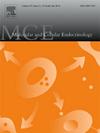LDT409(泛 PPAR 部分激动剂)可减轻高果糖喂养小鼠代谢功能障碍相关的脂肪性肝病。
IF 3.8
3区 医学
Q2 CELL BIOLOGY
引用次数: 0
摘要
目的:本研究旨在评估LDT409(一种从腰果加工过程中产生的主要工业废物中提取的泛PPAR部分激动剂)对高果糖喂养小鼠肝脏重塑、能量代谢和内质网(ER)应激的影响:雄性 C57BL/6 小鼠接受对照组饮食(C)或高果糖饮食(HFRU)十周。然后,开始为期五周的治疗:C、C-LDT409、HFRU 和 HFRU-LDT409。LDT409(40 毫克/千克体重)与饮食混合:结果:HFRU 日粮导致胰岛素抵抗和内质网(ER)应激。高Pparg和低Ppara表达增加了HFRU喂养小鼠肝脏的脂肪变性和促纤维化基因表达。在 PPAR-gamma 的协调下,致脂因子受到抑制,ER 应激得到缓解,同时 PPAR-α 驱动的β-氧化作用增加,这些因素介导了 LDT409 的有益作用:LDT409可能是治疗代谢功能障碍相关性脂肪肝的一种潜在低成本方法,目前尚无特效疗法。本文章由计算机程序翻译,如有差异,请以英文原文为准。
LDT409 (pan-PPAR partial agonist) mitigates metabolic dysfunction-associated steatotic liver disease in high-fructose-fed mice
Aim
This study sought to evaluate the effects of LDT409, a pan-PPAR partial agonist obtained from the main industrial waste from cashew nut processing, on hepatic remodeling, highlighting energy metabolism and endoplasmic reticulum (ER) stress in high-fructose-fed mice.
Methods
Male C57BL/6 mice received a control diet (C) or a high-fructose diet (HFRU) for ten weeks. Then, a five-week treatment started: C, C-LDT409, HFRU, and HFRU-LDT409. The LDT409 (40 mg/kg of body weight) was mixed with the diets.
Results
The HFRU diet caused insulin resistance and endoplasmic reticulum (ER) stress. High Pparg and decreased Ppara expression increased steatosis and pro-fibrogenic gene expression in livers of HFRU-fed mice. Suppressed lipogenic factors, orchestrated by PPAR-gamma, and mitigated ER stress concomitant with the increase in beta-oxidation driven by PPAR-alpha mediated the LDT409 beneficial effects.
Conclusions
LDT409 may represent a potential low-cost approach to treat metabolic dysfunction-associated steatotic liver disease, which does not currently have a specific treatment.
求助全文
通过发布文献求助,成功后即可免费获取论文全文。
去求助
来源期刊

Molecular and Cellular Endocrinology
医学-内分泌学与代谢
CiteScore
9.00
自引率
2.40%
发文量
174
审稿时长
42 days
期刊介绍:
Molecular and Cellular Endocrinology was established in 1974 to meet the demand for integrated publication on all aspects related to the genetic and biochemical effects, synthesis and secretions of extracellular signals (hormones, neurotransmitters, etc.) and to the understanding of cellular regulatory mechanisms involved in hormonal control.
 求助内容:
求助内容: 应助结果提醒方式:
应助结果提醒方式:


